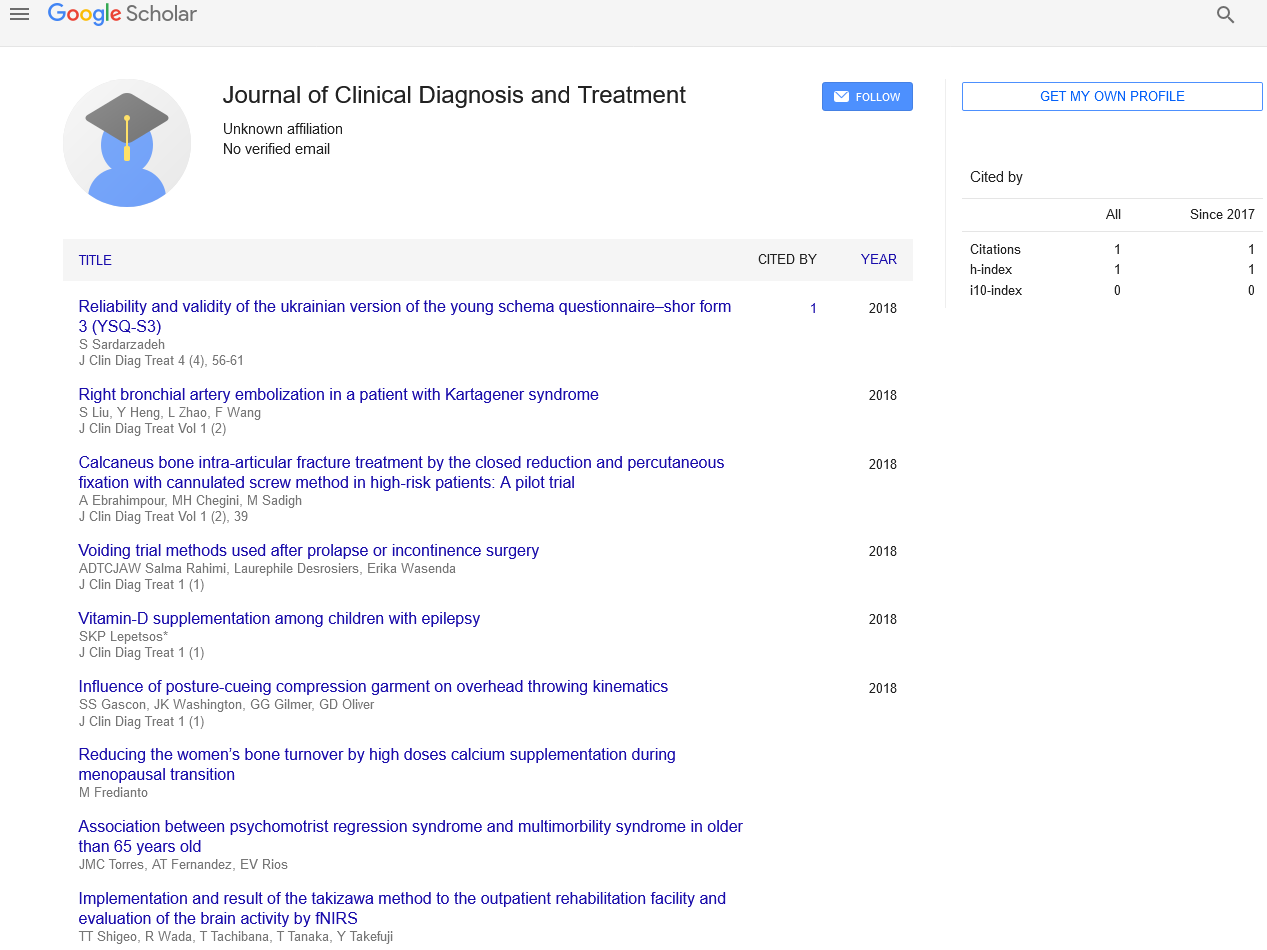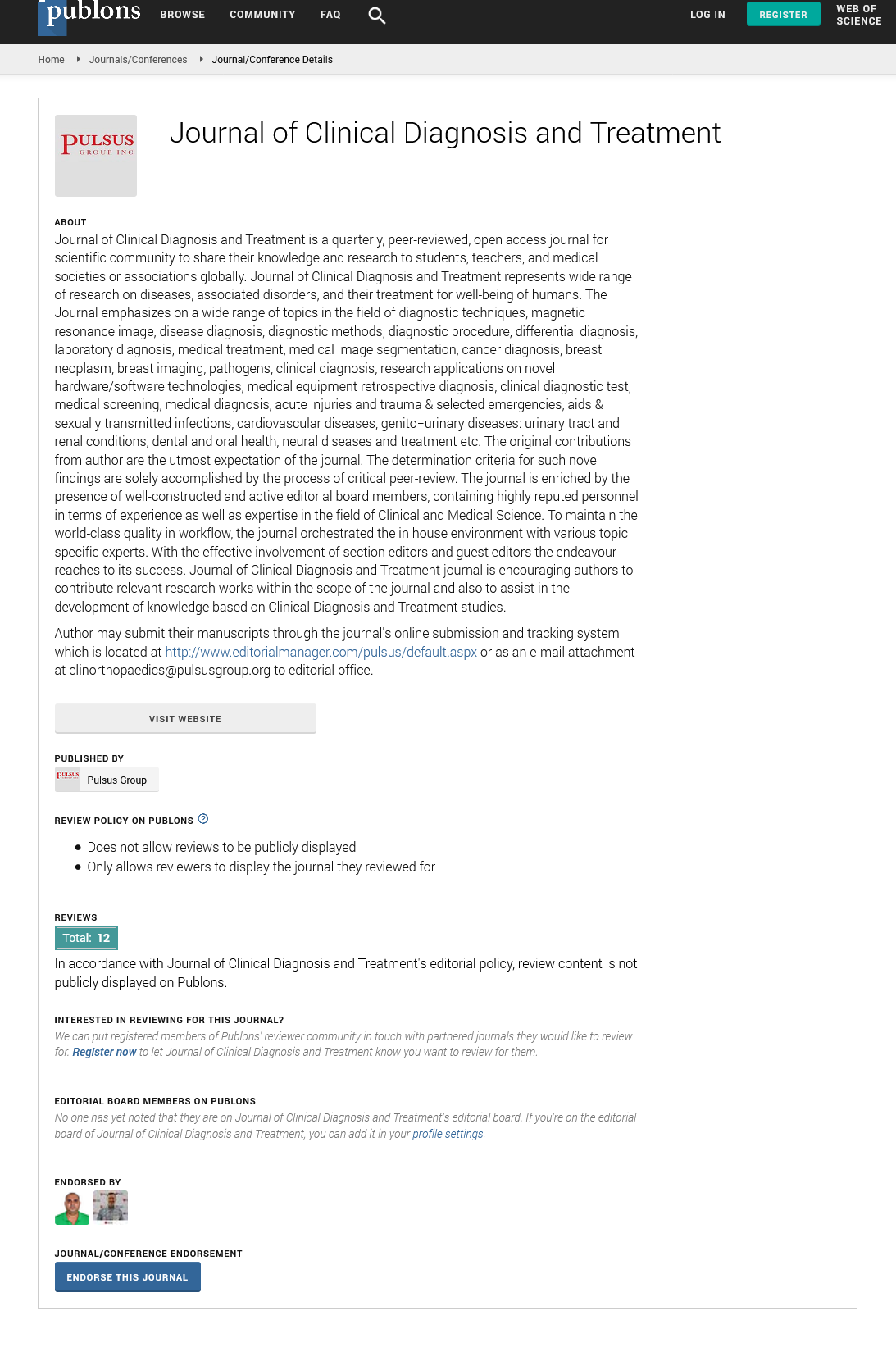Over Diagnosis or Under Diagnosis Leads to Unneeded or No Treatment
Received: 18-Feb-2022, Manuscript No. PULJCDT-22-4279; Editor assigned: 20-Feb-2022, Pre QC No. PULJCDT-22-4279(PQ); Reviewed: 28-Feb-2022 QC No. PULJCDT-22-4279(Q); Revised: 02-Mar-2022, Manuscript No. PULJCDT-22-4279(R); Published: 12-Mar-2022, DOI: : 10.37532/puljcdt.22.4(2).10-11
This open-access article is distributed under the terms of the Creative Commons Attribution Non-Commercial License (CC BY-NC) (http://creativecommons.org/licenses/by-nc/4.0/), which permits reuse, distribution and reproduction of the article, provided that the original work is properly cited and the reuse is restricted to noncommercial purposes. For commercial reuse, contact reprints@pulsus.com
Abstract
Diagnostic tests are methods used in clinical practice to accurately diagnose a patient's ailment and hence give prompt and appropriate therapy. The authors are exclusively responsible for reporting high-quality diagnostic test results, for both basic and advanced approaches. Despite the availability of recommendations and standards for statistical content and format, the quality of what and how the statistic is provided when a diagnostic test is evaluated ranged from outstanding to very poor. From the anatomy to the role in clinical practise to the statistical methods used to indicate their performances, this article briefly examines the procedures in the evaluation of a diagnostic test. The statistical approaches are accompanied by examples and are linked to the phase, clinical question, and objective. Phase I and II studies are discussed in greater depth, however phase III and IV research are only briefly discussed statistically. There are also other free internet services that can be used to calculate some data.
Introduction
In the management of any disease, an accurate and fast diagnosis with the lowest risk of misdiagnosis, missing diagnosis, or delayed diagnosis is critical. Both disease (the likelihood and severity of the disease) and diagnostic procedures evolve, therefore the diagnostic process is always changing. In clinical practise, appropriately identifying the diagnostic test that is appropriate for a certain patient with a specific illness is critical. Overdiagnosis or underdiagnosis leads to unneeded or no treatment, which is harmful to both the patients and the health-care system.
Standards for reporting clinical studies, including primary (e.g., casecontrol studies, cohort studies, and clinical trials) and secondary (e.g., systematic review and meta-analysis) research, have been developed. On April 20, 2019, the result of the effort was the posting of 412 guidelines on the EQUATOR Network. Each guideline is accompanied by a short checklist that describes the information that must be present in each section as well as some requirements for the presentation of statistical results (information about what, for example, mean (SD) where SD stands for standard deviation, and how to report, for example, the number of decimals). In evidence-based clinical practise, these criteria are also utilised to aid in the critical evaluation of an article. However, the minimum set of items or procedures, as well as their quality, have received insufficient attention in reporting the results. Several statistical guidelines, particularly for clinical trials, were developed to standardise the content of the statistical analysis plan, whether it was for phase III clinical trials in myeloid leukaemia, pharmaceutical industry-sponsored clinical trials, subgroup analysis, or graphics and statistics for cardiology.
The SAMPL Guidelines lay down the groundwork for reporting statistical procedures and outcomes. SAMPL recommends providing numbers with the appropriate level of precision, the sample size, numerator and denominator for percentages, and mean (SD) (where SD = standard deviation) for data that is approximately normally distributed; otherwise, medians and interpercentile ranges, verification of statistical tests' assumptions, name of the test and the tailed (one- or two-tailed), significance level, P values whether statistically significant or not, adjustment(s) (if any) (coefficient of determination) The diagnostic tests are frequently reported in the scientific literature, and the clinicians must know how a good report looks like to apply just the higher-quality information collected from the scientific literature to decision related to a particular patient. This review aimed to present the most frequent statistical methods used in the evaluation of a diagnostic test by linking the statistical treatment of data with the phase of the evaluation and clinical questions. Any diagnostic test lies somewhere between perfect and useless, and specific condition with confidence. Because there are no perfect diagnostic tests, any test will provide false-positive and false-negative results. The measure reported in the assessment of a diagnostic test's precision (variability analysis) or accuracy must be presented as point indicators with a 95 percent confidence interval, and the confidence intervals must be interpreted using the thresholds. The Bland and Altman plot (which evaluates the bias of the difference between two methods) rather than correlation or agreement analysis (which assesses the association between two measurements) is used to correctly evaluate the performance of two methods measuring the same result.
A gold standard test is required for evaluating a test's accuracy. To facilitate a fair evaluation of the accuracy, both sensitivity and specificity with 95 percent confidence intervals are reported combined. The clinical utility index is used to support the rule-in and/or rule-out, and hence the usefulness of a diagnostic test as illness diagnosis or screening, based on these results. When Youden's index is presented, the sensitivity and specificity must be reported at all times. The AUC with associated 95 percent confidence interval, the threshold according to Youden's index, sensitivity, and specificity with 95 percent confidence intervals are all included in the ROC analysis report.






